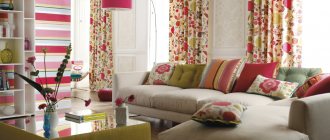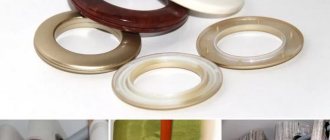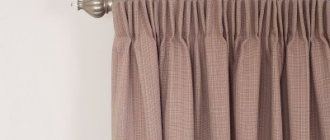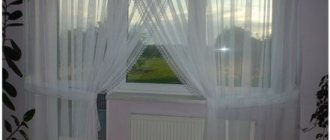Curtains are the completion, the point in creating the interior of a room. Holders with different tiebacks allow you to change the look of the room, creating drapes from curtains or opening a window. A wall hook is always visible, so it should fit well into the overall decor and style of the room. Sometimes holders are sold complete with a cornice, then they fit perfectly.
The holder can only stand on one side of the window if the other side is occupied by furniture.
You need to select fasteners based on the task they will perform, the material of the curtains, their design. The heavier the fabric, the stronger the holder itself should be and the more securely it should be attached to the wall. And vice versa - the fabric must correspond to powerful hooks.
Tiebacks made of fabric, braid, and beads in combination with elegant hooks are suitable for light curtains.
Show your imagination; self-made tiebacks will look original and please the eye.
Curtain fastenings
The market for manufacturers of curtain accessories is represented by a large number of fasteners, cornices, tiebacks, holders and other attributes for the beautiful and reliable design of window openings.
Curtains made of heavy fabrics require special fastening; not all clips can withstand considerable weight. But it is not always necessary to shade the windows in an apartment; sometimes light curtains are used simply to give the interior a homely feel and comfort.
A common, even classic option is the use of various hooks to decorate simple curtains and complicated compositions with lambrequins.
Organza, tulle, silk and other airy fabrics have almost no weight, so attaching such curtains to the curtain rod using special hooks is not difficult. Plastic, metal, metal-plastic - these and other types of curtain hooks will greatly facilitate the labor-intensive process of hanging curtains.
Installation height
By installing fasteners at different heights, you can get different effects - for example, visually expand the window or, conversely, lengthen it, change the lighting of the room.
Three ways to install the wall mount:
- Below the window sill (20-30 cm). Typically used for heavy curtains. The window will look narrow and let in little light, but this will hide the not very interesting view from the outside.
- Above the window sill, approximately 2/3 of the height of the room from the floor. The curtain will be gathered at the top. This method will allow you to open the window as much as possible and let a lot of light into the room. The window will appear wide. Suitable for medium weight and light curtains.
- At the level of the window sill or slightly higher, up to half the height of the room. A universal method, it beautifully separates the curtain vertically, and the window lets in daylight well.
Which method to choose depends on the purpose of the room, the size of the window, the view opening from it, the material of the curtains and the design of the room.
The first installation method is used in rooms where darkening may be required - in the office, bedroom. The second is in the kitchen or workshop, where a lot of light is required (in addition, assembled curtains are less dirty). The third is suitable for most other rooms - living rooms, children's rooms, halls.
Another type of hooks
Along with plastic hooks for curtains, consumers also pay attention to metal hooks. Very rarely, these products are made of steel; more often, aluminum and brass are used for their manufacture. They are much stronger than plastic ones and have a longer service life.
Many decorative models of various shapes of metal hooks are produced, which, in addition to the main function of supporting curtains, are a decoration and addition to the intended design. When creating comfort and coziness in a living area, metal accessories look more attractive than their plastic competitors.
For curtains made of thick fabric, metal fittings are the most acceptable option, but they also won’t cope with very heavy curtains and won’t support the extra weight.
When buying hooks made of metal, you can't go wrong with quality: low-quality products are susceptible to corrosion and can become stained over time and leave stains on the fabric.
Aluminum is quite cheap and light, but not strong enough.
Brass has an attractive appearance, similar in color to gold. Durable if the manufacturing technology is not violated.
Steel is a budget option; you need to be careful when choosing products made from this metal.
Useful tips
When choosing the type of curtain hooks, it is also important to consider the size of the loops, the weight of the curtains, as well as the type of curtain rod.
Advice! When purchasing hooks, professionals recommend taking into account the stylistic features of the interior, as well as the frequency of use of cornices and curtains.
For example, for lightweight curtains that will always be placed in one position, transparent plastic hooks are suitable. To make them invisible to others, designers try to sew them to curtain tape.
Photo of curtain hooks
Choosing a location for the holder
You definitely need to try the chosen option. Ask someone to help you and hold the grip in the right place, and see for yourself how it looks from the outside. Try setting the hook to different heights, moving it left and right, and evaluate the result. Use light pencil or chalk strokes to mark the selected location. Make sure that there are no electrical wires running there, there are no sockets or switches lower in height (according to regulations, the wire must run vertically upward from the socket). It's good if you have a diagram or photos of the wiring.
The holder has holes for mounting. It is necessary to carefully mark the centers of the holes on the wall.
How to attach a hook to a concrete wall
If the wall is made of brick, block or concrete, you will need screws and dowels (usually fasteners of the required size are included in the kit). If the holder will bear a large load, the dowels should be at least 5-6 cm in length.
To drill holes in such walls, you need a hammer drill or impact drill (nowadays, in many stores that sell power tools, you can rent one for a couple of hours). A drill for a hammer drill or a drill with a pobedite tip (for concrete) is taken according to the diameter of the dowel. Step by step:
- Drill the hole slightly deeper than the length of the dowel. During the process, you can bring a hose from a running vacuum cleaner to the drill, dust and sand will not fly around the room;
- dowels are inserted into the hole with light blows of a hammer;
- The holder is screwed on with screws. Installation completed.
Individual approach
You can make your own curtain holders from materials and parts lying around in the pantry . In the kitchen, holders made from cutlery will look original. All you have to do is find interesting forks or spoons, bend the handle at the desired angle and attach the holder to the wall. It is absolutely not necessary that the devices be from the same set or the same type.
Old door handles of absolutely any configuration can also serve as a holder: stationary (you will have to pass the blade through them, so the handle must be wide enough), round or L-shaped. Vintage options will look interesting, for example, with forged or faience elements, and wooden handles will add special charm and comfort to the room.
Features of grabs
In its configuration, the grab is a loop created from two ends of fabric attached to the wall. The curtains are gathered into a bun (drapery) and then strengthened with a tieback. Methods of draping fabric directly depend on its density and heaviness: along with light curves, people fell in love with wide and lush coattails.
If we consider the types of curtain fastenings, then their choice is quite wide. Tiebacks include everything that can hold the canvas in an assembled and fixed position on its side:
- laces of various thicknesses;
- braid decorated with decorative stitching;
- textile strips;
- leather straps;
- hook for picking up curtains;
- twine;
- vintage style door handles;
- floral and romantic decorative compositions;
- in the form of hairpins;
- beads, etc.
Magnetic holders, which are available in a wide range of colors and different shapes, appeared on the market relatively recently, but have already managed to interest buyers.
Depending on the material used, the grab bars can be textile, wood, metal, leather or plastic. With a creative approach, any element becomes a fabric holder: hairpins, toys, artificial flowers and butterflies sewn onto braid.
The aesthetic value of the tieback is that it can give an updated look to even old curtains, and in addition, it is an independent decorative unit.
- Updating your interior with fresh and trendy touches.
- Curtains with tiebacks benefit from composition, and with the help of drapery, unique textile forms are obtained that are securely fixed.
- The opportunity to implement a variety of creative ideas in the decorative design of the room.
Also, when using holders, there is no need to constantly curtain the window, as a result of which the fabric wears out faster.
Examples in the interior
The choice of hooks today is huge. Therefore, choosing an option suitable for a specific room is not at all difficult. In addition to simple plastic accessories, there are also unusual designer metal models that do not need to be hidden from strangers, as they themselves will become a kind of decor. Samples of hooks and their use in window decoration can be seen in the photo.
At first glance, the hook on which curtains are hung is a trifle. However, you shouldn't skimp on them. Otherwise, you can ruin the curtain and the overall appearance of the room.











